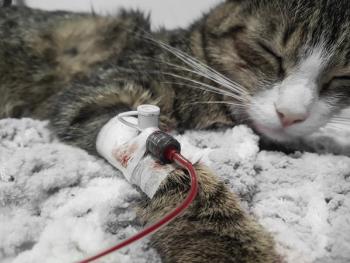
Stapling applications in abdominal surgery (Proceedings)
For certain procedures in the abdominal cavity, surgical staples may be an appropriate alternative to suturing.
For certain procedures in the abdominal cavity, surgical staples may be an appropriate alternative to suturing. Surgical staples are inert and efficient and, when used appropriately, staples and stapling devices minimize tissue handling and contamination, perform reliable and secure closures, and provide excellent hemostasis. Disadvantages are that the equipment can be expensive and veterinarians may not be as familiar or comfortable with stapling as they are with suture. The most common staplers utilized in small animal general surgery are the ligating dividing stapler (LDS), the thoracoabdominal (TA) stapler, and the gastrointestinal anastomosis (GIA) stapler. Less commonly used staplers are the end-to-end anastomosis (EEA) stapler and the intestinal linear anastomosis (ILA) stapler.
The LDS simultaneously places two U-shaped vascular clips across and transects a vascular pedicle. This instrument is typically used during splenectomies for rapid ligation and division of the multiple small splenic vessels. It can also be used to address the vessels in the broad ligament during a large dog ovariohysterectomy. The main disadvantage of the LDS is that it is more expensive to use than suture ligation. However, this may be offset by the reduction in surgical and anesthetic time.
TA staplers place two staggered rows of B-shaped staples. The B-shaped configuration is compressive enough to provide hemostasis, but is noncrushing, which allows for microcirculation to reach the wound edge and prevent tissue necrosis. Cartridges come in lengths of 30, 55, and 90mm and are different colors relative to staple dimensions (Table 1).
Table 1. TA staple characteristics
TA staplers are commonly utilized for lung lobectomy, liver lobectomy, and partial gastrectomy, although there are multiple other uses. A specific vascular cartridge (30mm – V3; white) can be used in a TA stapler that places three staggered rows of B-shaped staples. This cartridge is indicated for closure of large vessels or resection of highly vascularized tissue. Specific examples for using a TA stapler with V3 cartridge are lung lobectomy, partial splenectomy, nephrectomy, and right auriculectomy.
Surgical staplers can be used in a number of ways to create end-to-end intestinal anastomoses. Advantages of stapled anastomoses include increased speed, higher tensile strength, and minimal inflammation. The main disadvantage is the high cost of instrumentation and cartridges; some procedures also require familiarity and experience with the equipment to be performed properly. Also, the small size of the small intestine may restrict stapler application. Techniques for stapled intestinal anastomosis include:
• Triangulating end-to-end anastomosis using a TA stapler
• Functional end-to-end or side-to-side anastomosis using GIA and TA staplers
• Inverting end-to-end anastomosis using EEA and TA staplers
The GIA stapler is a linear device with two interlocking pieces. Staple characteristics for the GIA are similar to those for the TA. The GIA stapler places two double rows of staggered B-shaped stables 3.5mm apart and then incises in between. It is used most often in combination with a TA stapler to create functional end-to-end anastomoses.
The EEA stapler places a circular double-row of staples. The EEA stapler is ideal for creating inverting end-to-end or end-to-side anastomoses. A circular blade within the cartridge resects the redundant inverted tissue to create a new lumen. This stapler is most commonly utilized in veterinary surgery to perform subtotal colectomy in cats. However, the size availability and somewhat difficult application of the EEA stapler limits its use.
References
Pavletic MM, Schwartz A: Stapling Instrumentation. Vet Clin North Amer (Sm Anim Pract) 24:247-278, 1994
Tobias KM. Surgical stapling devices in veterinary medicine: a review. Vet Surg 36:341-349, 2007
Newsletter
From exam room tips to practice management insights, get trusted veterinary news delivered straight to your inbox—subscribe to dvm360.




